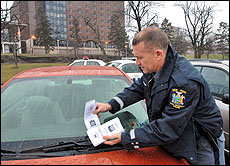Archives
Would your car make the grade?
University Police raising awareness of vulnerability to vehicle break-ins
By SUE WUETCHER
Reporter Editor
Would you get a passing grade on your vehicle-burglary report card? Or is your car a target for would-be thieves?

Wayne Colton, community liaison
officer for University Police, places an Auto Burglary Report Card under
a windshield wiper of a car parked in the Main-Bailey Lot, South Campus,
on Monday.
PHOTO: NANCY J. PARISI
Many UB drivers will get the opportunity to find out as part of a multimedia campaign designed by University Police to increase drivers’ awareness of their vulnerability to automobile break-ins.
The University Police Vehicle Burglary Initiative 2008, developed by Wayne Colton, community liaison officer, began on Monday and will continue through Jan. 25. Its objective is to reduce the instances of auto burglary at UB through the use of signs, brochures, public service announcements, stepped up patrols and a vehicle burglary report card.
The initiative initially is targeted toward South Campus, where 27 vehicle burglaries were recorded in 2007, a sharp increase over the past few years, Colton said. He described these burglaries as traditional “smash and grab” incidents, where windows in the vehicles were broken and items, usually car radios, GPS units, I-pods and other small electronic devices, were taken.
“Auto-burglary prevention, like all crime prevention, involves limiting the criminal’s ability and/or opportunity to commit the crime,” Colton said. “With very little time and effort, citizens can make a huge difference in their vulnerability to auto burglary.”
University Police has erected “safety alert” signs in several key locations on the South Campus, including at entrances to Sherman, Farber, Squire and Harriman halls, Kimball Tower, the Buffalo Materials Research Center building and at the main entrance to the Health Sciences Library. The message on the signs urges drivers not to leave valuables in plain sight in their cars and to be vigilant for suspicious activity in and around campus parking lots. The signs also provide the telephone number for University Police—645-2222—and direct individuals to use any Blue Light Phone to contact University Police.
That message also is being broadcast through Jan. 25 on UB-Alert 1620-AM, the campus traffic radio station, and through Feb. 12 on MyUB , a Web-based personal portal; on University Police’s Web site ; and on the Campus Road Condition Hot Line (645-2345), a daily update of weather, road conditions and school closing information.
Uniformed student police aides distributed vehicle burglary report cards to vehicles parked in the Sherman, Main-Bailey and Michael-Farber lots from 9 a.m. to 4 p.m. on Monday and Tuesday. The aides graded cars based on whether they observed conditions that could lead to a break-in, such as property left in plain view, keys left in the vehicle, a window left open or other unsafe conditions. Aides noted the license plate and hangtag numbers of any vehicles receiving a failing grade and attempts will be made to contact the owner to emphasize the safety message, Colton said.
The report card also will be available in dispensers at the free-standing safety alert signs and in the Parking and Transportation Services offices in 102 Spaulding Quad, Ellicott Complex, North Campus, and 104 Harriman, South Campus.
Although the current safety initiative is geared toward South Campus—Colton called the 2007 statistics for vehicle break-ins on North Campus “insignificant”—he urged drivers who park on the North Campus to be aware as well of unsafe conditions in their vehicles.
“It generally takes a mere few seconds to secure your valuables, but it will take only a few seconds more for a thief to break in and steal valuables left in plain sight,” he said. “The key to crime prevention is a partnership through education.”
Colton said he will be monitoring conditions on both campuses and the initiative will be adjusted as needed. “It’s a living breathing program," he noted.
For further information, click here or call University Police at 645-2227.
